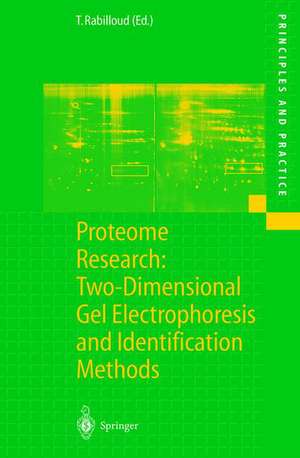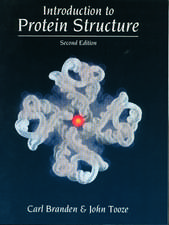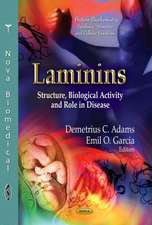Proteome Research: Two-Dimensional Gel Electrophoresis and Identification Methods: Principles and Practice
Editat de T. Rabillouden Limba Engleză Paperback – 17 sep 1999
| Toate formatele și edițiile | Preț | Express |
|---|---|---|
| Paperback (1) | 1209.52 lei 6-8 săpt. | |
| Springer Berlin, Heidelberg – 17 sep 1999 | 1209.52 lei 6-8 săpt. | |
| Hardback (1) | 1221.51 lei 6-8 săpt. | |
| Springer Berlin, Heidelberg – 17 sep 1999 | 1221.51 lei 6-8 săpt. |
Din seria Principles and Practice
- 15%
 Preț: 638.76 lei
Preț: 638.76 lei - 18%
 Preț: 1398.00 lei
Preț: 1398.00 lei - 18%
 Preț: 946.55 lei
Preț: 946.55 lei - 15%
 Preț: 637.78 lei
Preț: 637.78 lei - 18%
 Preț: 1224.36 lei
Preț: 1224.36 lei - 18%
 Preț: 1229.40 lei
Preț: 1229.40 lei - 5%
 Preț: 362.88 lei
Preț: 362.88 lei - 18%
 Preț: 953.03 lei
Preț: 953.03 lei - 15%
 Preț: 646.94 lei
Preț: 646.94 lei - 15%
 Preț: 644.95 lei
Preț: 644.95 lei - 5%
 Preț: 1104.68 lei
Preț: 1104.68 lei - 18%
 Preț: 1545.75 lei
Preț: 1545.75 lei - 15%
 Preț: 639.41 lei
Preț: 639.41 lei - 5%
 Preț: 710.06 lei
Preț: 710.06 lei - 18%
 Preț: 952.89 lei
Preț: 952.89 lei
Preț: 1209.52 lei
Preț vechi: 1475.02 lei
-18% Nou
Puncte Express: 1814
Preț estimativ în valută:
231.44€ • 242.14$ • 192.26£
231.44€ • 242.14$ • 192.26£
Carte tipărită la comandă
Livrare economică 02-16 aprilie
Preluare comenzi: 021 569.72.76
Specificații
ISBN-13: 9783540657927
ISBN-10: 3540657924
Pagini: 268
Ilustrații: XVI, 248 p.
Dimensiuni: 155 x 235 x 14 mm
Greutate: 0.36 kg
Ediția:2000
Editura: Springer Berlin, Heidelberg
Colecția Springer
Seria Principles and Practice
Locul publicării:Berlin, Heidelberg, Germany
ISBN-10: 3540657924
Pagini: 268
Ilustrații: XVI, 248 p.
Dimensiuni: 155 x 235 x 14 mm
Greutate: 0.36 kg
Ediția:2000
Editura: Springer Berlin, Heidelberg
Colecția Springer
Seria Principles and Practice
Locul publicării:Berlin, Heidelberg, Germany
Public țintă
ResearchCuprins
1 Introduction: The Virtue of Proteomics.- 2 Solubilization of Proteins in 2D Electrophoresis.- 1 Introduction.- 2 Rationale of Solubilization-Breaking Molecular Interactions.- 3 Initial Solubilization.- 4 Solubility During IEF.- 5 Conclusions: Current Limits and How to Push Them.- References.- 3 Two-Dimensional Electrophoresis with Carrier Ampholytes.- 1 Introduction.- 2 Sample Preparation.- 3 First Dimension. Standard Isoelectric Focusing.- 4 Second Dimension. Standard Slab Gel Electrophoresis.- 5 Modification of the Standard Two-Dimensional Gel Method.- 6 Visualization of Separated Proteins: Silver Staining.- References.- Appendix: Problems and Troubleshooting.- 4 Two-Dimensional Electrophoresis with Immobilized pH Gradients.- 1 Introduction.- 2 Sample Preparation.- 3 First Dimension: IEF with IPGs.- 4 Equilibration of IPG Strips.- 5 Second Dimension: SDS-PAGE.- References.- Appendix A: General Troubleshooting.- Appendix B: Troubleshooting for IPG and Horizontal PAGE.- 5 Detection of Proteins on Two-Dimensional Electrophoresis Gels.- 1 Introduction.- 2 Detection by Organic Dyes.- 3 Detection by Differential Precipitation of Salts.- 4 Detection by Metal Ion Reduction (Silver Staining).- 5 Detection by Fluorescence.- 6 Detection of Radioactive Isotopes.- 7 Conclusions and Future Prospects.- References.- 6 Blotting and Immunoaffinity Identification of Two-Dimensional Electrophoresis-Separated Proteins.- 1 Introduction.- 2 Protein Transfer onto Membranes.- 3 Membrane Staining.- 4 Immunodetection.- 5 Assignment of Two-Dimensional Immunoreactive Spots by Matching.- References.- 7 Identification of Proteins by Amino Acid Composition After Acid Hydrolysis.- 1 Introduction.- 2 Blotting of Proteins from Gels to PVDF Membranes.- 3 Hydrolysis of PVDF-bound Proteins.- 4 Extraction of Amino Acids from PVDF Membranes.- 5 Derivatization and Chromatography.- 6 Amino Acid Analysis Troubleshooting Guide.- 7 Protein Identification by Database Matching.- 8 Identification by N-Terminal Sequence Tags and Amino Acid Composition.- 9 Conclusions.- References.- 8 Identification by Amino Acid Composition Obtained from Labeling.- 1 Introduction.- 2 Choice and Labeling Amino Acids.- 3 Single Labeling Method.- 4 Double Labeling Method Based on 35S Decay.- 5 Double Labeling Method using Scintillation Counting.- 6 Determination of pI and Mr.- 7 Construction of the Database.- 8 Search in a Protein Database.- 9 Result Analysis.- 10 Conclusion.- References.- 9 Identification of Proteins by Amino Acid Sequencing.- 1 Purpose of Protein Sequencing.- 2 N-Terminal Sequence Analysis by Edman Chemistry.- 3 Other Possibilities for Generation of Amino Acid Sequences.- 4 The Interface from Two-Dimensional Gel.- 5 Conclusion.- 6 Perspectives.- References.- 10 Identification of Proteins by Mass Spectrometry.- 1 Introduction.- 2 Protein Preparation Methods Compatible with MS.- 3 Enzymatic Digestion of Proteins.- 4 Sample Clean-up for ESI-MS and On-line Liquid Chromatography.- 5 Sample Clean-up for MALDI-MS.- 6 Mass Spectrometers.- 7 Protein Identification by Correlating MS DATA with Sequence Databases.- References.- 11 Mass Spectrometry of Intact Proteins from Two-Dimensional PAGE.- 1 Introduction.- 2 Elution of Proteins from Gels for Mass Spectrometry.- 3 Mass Spectrometry of Proteins Electroblotted onto Polymer Membranes.- 4 UV-MALDI Mass Spectrometry of Proteins Directly from Polyacrylamide Gels.- 5 Conclusion.- References.
Textul de pe ultima copertă
Proteomics, a branch of functional genomics, can be defined as the large-scale analysis of proteins. In all these large-scale analysis processes there are three phases: (1) separation of the molecules to be analyzed; (2) characterization of the separated molecules; and (3) managing, handling and analysis of the data. This book is centered on the first two phases of proteomics, i.e. separation by two-dimensional electrophoresis and microcharacterization of the separated proteins. This choice is due to the fact that the data production phase is the major bottleneck of proteomics, while it is not the case in standard genomics. Emphasis has been placed on the rationale of each technique, so that the reader will be able to keep pace with the rapid evolution of the techniques. However, up-to-date protocols are also given to help the beginner in the field.
Caracteristici
This is the first book to comprehensively cover the application of 2D gel technology to the field of proteomics Includes supplementary material: sn.pub/extras













